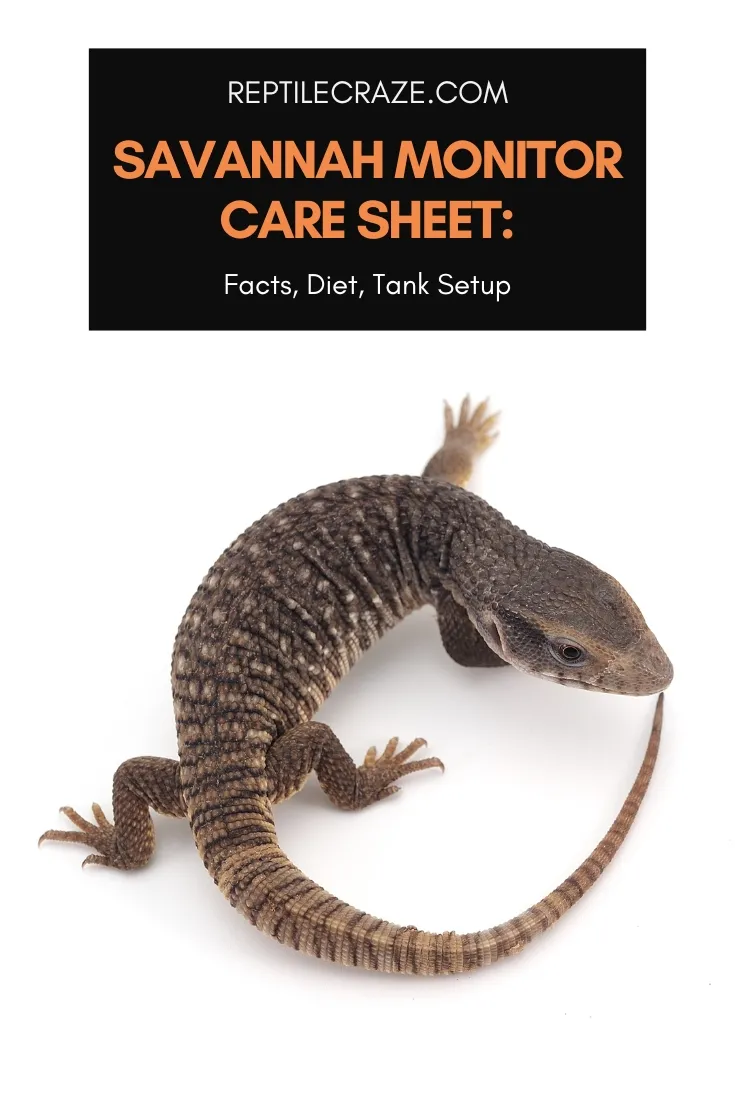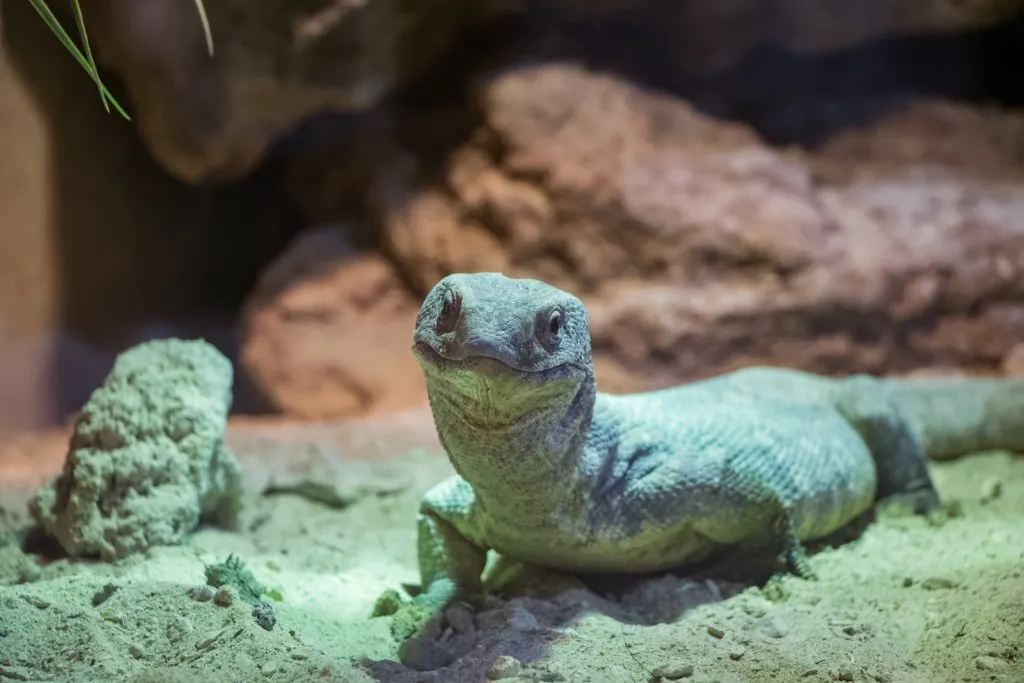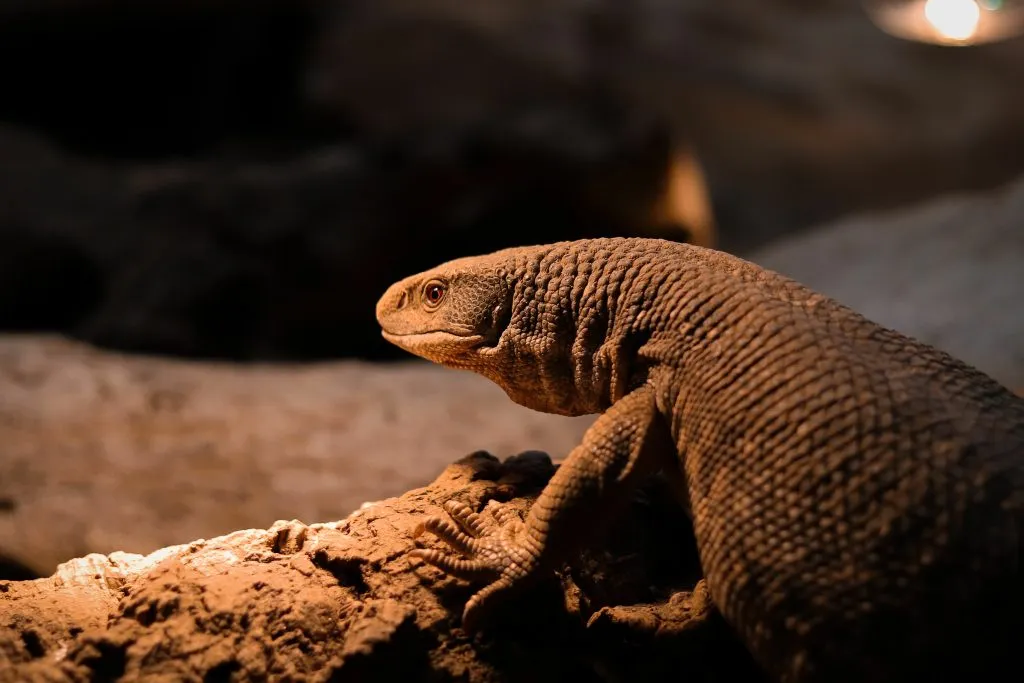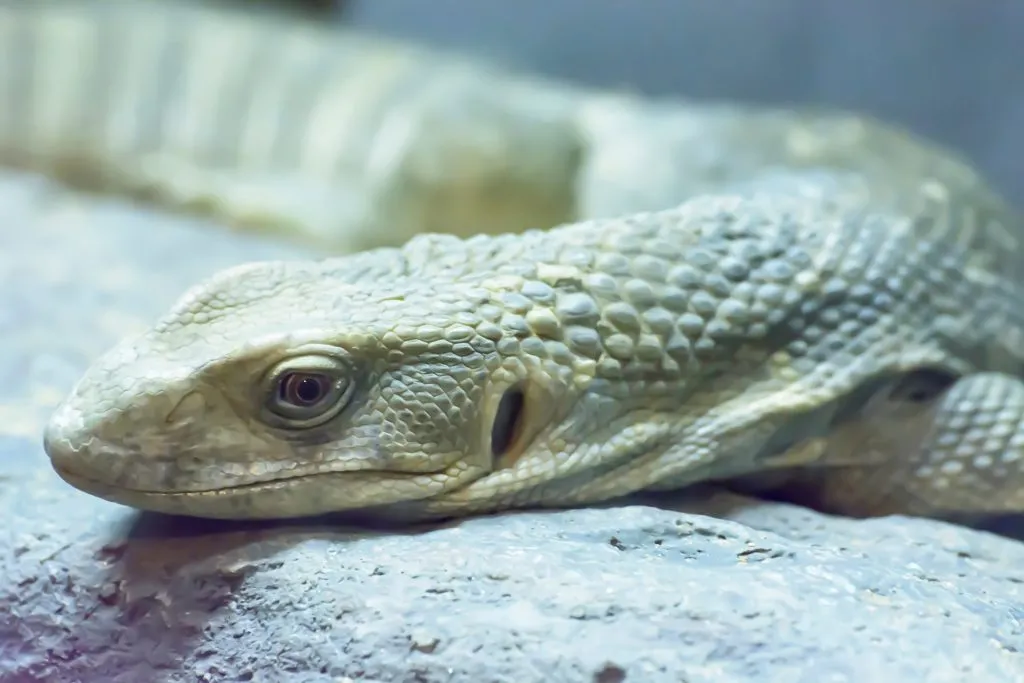
Savannah monitors can make great pets if you want a large reptile that is easy to take care of and fairly docile. When handled as juveniles, they are easy to tame for handling with their owners as they get older. If you have been considering getting one of these reptiles, here is what you need to know about their care.
Table of Contents
Savannah Monitor Reptile Facts
| Common Name | Savannah monitor |
| Scientific Name | Varanus exanthematicus |
| Natural Habitat | Desert-dwelling in central Africa |
| Adult Size | Up to 5 feet |
| Enclosure Size | 6’ x 4’ x 4’ minimum |
| Diet | Insects and small rodents |
| Lifespan | 15 to 20 years |
| Experience Level | Advanced |
Where Do Savannah Monitors Live?
Savannah monitors are native to the African continent, mostly in the central regions.
In particular, they are found in the both the savannah and grassland regions of sub-Saharan Africa including countries like Ethiopia, Ghana, Cameroon, and Democratic Republic of the Congo.
Savannah Monitor Appearance, Colors And Morphs
These reptiles are some of the largest lizards that you will come across with many maturing to be around two to five feet long.
One of their defining characteristics is their large head coupled with a shorter neck and a shorter tail. All savannah monitors have a blue forked tongue that they use to monitor their environment.
In general, the color of this reptile tends to err more on the yellow side though you may find a few savannah monitors that have a greyer color to them. Males tend to be more yellow to gold whereas a female typically is a bit browner.
Both male and female have round markings in lighter shades of yellow down the back and often extending to the tail.
This pattern is separated by dark edges that define each individual marking. Their abdomens are usually lighter in color with a dark brown pattern.
How Big Do Savannah Monitors Get?
Savannah monitors are some of the largest reptiles that you can keep in an enclosure. They can reach a length of 2.5 – 4.0 feet. Some savannah monitors can even reach 5 feet in length, but that’s rather unusual.
The video below shows you how big savannah monitors usually get and how small they are as babies.
Savannah Monitor Lifespan
These reptiles are not for those who are thinking about dabbling in the world of reptile care as they have an impressive lifespan.
Most will live for fifteen to twenty years when well taken care of in captivity. In the wild, their lifespan may be a bit on the shorter side.
How to Care for Savannah Monitors
Let’s have a look at what you need to properly care for them.
Savannah Monitor Tank Setup
While hatchlings might be able to get away with a smaller enclosure, adults will need something relatively large due to their overall size.
It is best to look for a terrarium or enclosure that is at least five to six feet long by four feet wide and four feet deep. If you can accommodate it, a larger enclosure is always nice but this is the absolute minimum.
Lighting and Temperature
Savannah monitors are used to living in sunny and warm central Africa, and you will need to replicate this environment in your enclosure at home.
To this end, they will need about ten hours of light per day. Your light should also pull double duty, keeping the temperature in the enclosure between 90- and 100 degrees Fahrenheit during the day.
Most people prefer to use mercury vapor bulbs like the Exo Terra Solar Glo that can give the UVB that this reptile needs, as well as the heat they require.
To keep your savannah monitor comfortable even at night when the light is off, you may choose to implement heating pads like the Zoo Med Repti Therm Under Tank Heater.
Do Savannah Monitors Need UVB?
Yes, savannah monitors do require UVB in order to properly metabolize their calcium. This is why we recommend the Exo Terra Solar Glo because it provides heat output as well as UVB to keep your reptile nourished and healthy.
Substrate
In their natural habitat, savannah monitors love to dig so you will want to choose a substrate that allows them to do just that.
To this end, you might want to use the Zoo Med Repti Bark (click here) or a more natural sand product that you can combine with soil like this one from Exo Terra (here is our review of the Exo Terra Desert Sand).
Humidity

It might come as a surprise that these desert-dwelling reptiles actually prefer to reside in a moist enclosure. The savannah monitor thrives in humidity levels that top 60%, so be sure to get a quality hygrometer to monitor the humidity in your enclosure.
To achieve such humidity levels, regularly mist the
They need the right humidity in order to shed properly. We explain everything on shedding in savannah monitors here.
Savannah Monitor Tank Décor
You won’t want too many décor items in your savannah monitor cage, as they tend to get pushed to the side when your reptile digs and crawls around.
However, you will want to include a hide for them to rest and sleep in. These Cork Rounds are a great option. They come in a jumbo size perfect for adult monitors but can easily be cut down for hatchlings or juveniles.
While natural plants won’t often survive the heat conditions in the enclosure, you can still use some fake plants to jazz up the space. For example, you can get desert flora from Zoo Med such as the silver mullein.
How to Clean a Savannah Monitor Tank
For the most part, you can get away with spot-cleaning the
Always be sure to scrub the water dish when this happens to prevent them from catching parasites.
If you happen to be using the Zoo Med Repti Bark, then you can always wash the substrate and put it back in the enclosure.
Even the Exo Terra sand is easy to spot clean and replace at regular intervals. Generally speaking, they are not terribly messy reptiles but spot cleaning is necessary to keep them healthy and happy.
Savannah Monitor Diet

Here is how you should feed your savannah monitor:
What to Feed
The diet of a happy and healthy savannah monitor varies depending on their age and stage of life. Juveniles tend to be content to munch on insects and worms.
This will continue to be a staple item of their diet even into adulthood. Insects like roaches and worms are full of nutrition that can keep them healthy long-term.
However, adults may also enjoy larger prey from time to time. Some savannah monitor owners like to give rodents like mice a couple of times each week.
How Often to Feed
The age of your reptile dictates how frequently it will need to eat. Adults feed less frequently, particularly if they are larger in size or overweight.
For the most part, one to two feedings per week is sufficient for a full-grown monitor. On the other hand, juveniles will need to be fed two to three times weekly.
Babies require the most frequent feedings and should be given fresh
How Long Can They Go Without Food ?
If you are thinking about taking a trip or if your savannah monitor simply refuses to eat, you might wonder if it will harm them.
The good news is that their bodies are designed to go without
Most experts agree that they can technically go six months without a meal, so there is no need to fret if you have to leave town for a few days or if they refuse a meal.
We explain this in more detail here.
Do Savannah Monitors Need Water?
Savannah monitors need lots of water to stay healthy, but they use their water dish for more than just hydration. Oftentimes, they will climb right into the dish and soak to make themselves more comfortable.
This is why you will need a heavy water dish. They also tend to defecate in the water so you will need to clean this bowl on a regular basis and check to see if your monitor requires fresh.
Vitamins and Minerals
If you feed your savannah monitor insects, you should dust them with a calcium supplement to ensure that your monitor is getting everything they need from their diet.
You can skip this step when feeding mice as they will get everything they need from the rodent. It is also a great idea to give a multivitamin like Herptivite once per week.
Savannah Monitor Behavior and Temperament

For the most part, savannah monitors are laid-back lizards that may not do much beyond digging through the substrate of their enclosure.
Burrowing and digging during the day is their favorite pastime, but you will still find that they spend a lot of their time sleeping or basking.
They can be quite easy to handle if they were introduced to it when young. Adults who were not properly introduced to handling at a young age have a tendency to be more aggressive and may even bite their owners.
You may have fair warning that they are unhappy being handled, as they do hiss when feeling threatened.
When they are unsure about being handled, you might also encounter some tail whipping as they try to fend off threats.
If they do bite, the good news is that they are not venomous, and you will just need to clean the wound thoroughly.
Are Savannah Monitors Good Pets For Beginners?
Even though savannah monitors tend to be calm when tamed, they are not good pets for beginners. Their big claws and strong bites can be dangerous, especially for kids.
We show you how bad these bites can be in this article here and we show you how dangerous they can be in this article.
Besides that, these reptiles require huge enclosures and a lot of
Also, finding a pet sitter for a reptile this big can be a challenge.
Do savannah monitors like being handled?
When juveniles are exposed to handling from an early age, they are more likely to be docile when handled as adults.
Because of their calm demeanor, they make great pets for owners who like to handle their reptiles.
If you plan to handle them, pick them up from the belly while supporting their chest and hind limbs. Their tail should be supported by your arm.
Always move slowly when picking up your monitor and only handle them when they are awake and active (during the day or in the early evening). Avoid direct eye contact and keep hands away from their face.
We have a full guide on how to handle your savannah monitor here.
Savannah Monitor Common Health Problems
Even when kept in the ideal circumstances, you will find that your savannah monitor is prone to a few common health problems like parasites and respiratory infections.
Parasitic infections can come from consuming water where they have defecated or via infected
Internal parasites often show up as a lazier-than-usual lizard who refuses meals when they typically have a great appetite.
Respiratory infections are another primary concern that should be addressed by a veterinarian.
If you notice that your savannah monitor is breathing with their mouth open, wheezing, has discharge from their mouth and nose, has more lethargy than usual, or lack of appetite, it might be time to take them to the vet.
We provide more information on diseases and disease symptoms in savannah monitors in this guide.
Where to Buy Savannah Monitors

Finding a reputable breeder for your next savannah monitor is essential to getting a healthy pet who will be ready for you to handle and tame.
There are very few breeders who specialize in this type of reptile, so finding one can be a bit of a challenge.
Backwater Reptiles is one breeder that allows you to get your monitor shipped to your doorstep in record time.
We recommend trying to find a savannah monitor who is being rehomed or through a rescue to cut back on the capture of wild savannah monitors and to give these reptiles a home where they are wanted and properly cared for.
We have compiled a list of reputable savannah monitor breeders here (some of them ship worldwide).
Savannah Monitor Price
These reptiles tend to be very affordable, ranging in price from $50 to $100.
Savannah Monitor Breeding
Many people find that breeding savannah monitors is tricky if you aren’t experienced in this area.
Keeping the mating pair together in the enclosure means you will need an even bigger space for them to comfortably roam. Feed more regularly (up to three times per week) to help the female to produce a batch of eggs.
You will also need to reduce the light from 10 to 12 hours a day to 7 hours a day to set the mood for your reptiles.
Allow the male to pursue the female as much as he wants until she caves. Make sure that the substrate is sand to allow the female to burrow her eggs. These eggs will need to incubate for five to six months.
Taking Care of Your Savannah Monitor
Taking care of a new savannah monitor is a fun task for a reptile lover. They are easy to handle and are great pets for beginners who understand the finer points of what they require.
If you are thinking about adding one of these reptiles to your collection, keep these tips in mind to keep them happy and healthy well into the future.
- Enchi Ball Python: A Unique and Stunning Morph of Python regius - March 27, 2025
- Emerald Tree Monitor: The Enigmatic Green Guardian of the Rainforest - March 26, 2025
- The Egyptian Cobra (Naja haje): A Fascinating Serpent - March 25, 2025
